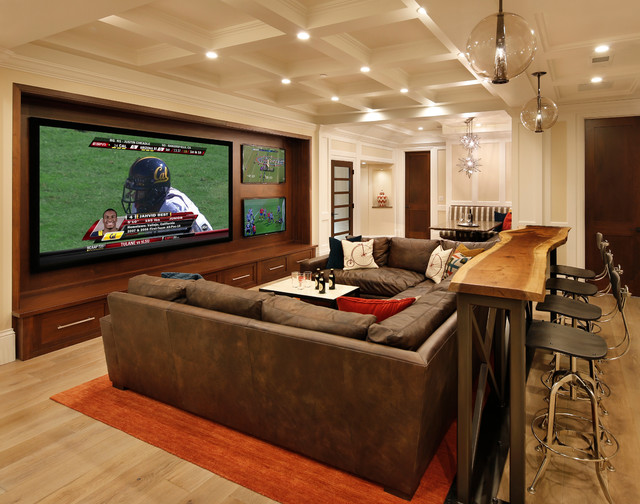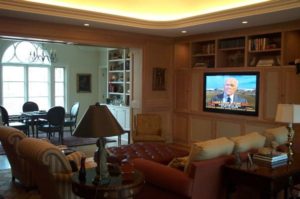Design the Perfect Home Theater TV Room

Designing and building a home theater can be the perfect addition to a home. It creates a great place to watch television or movies and enjoy the program with minimal distractions. Since home theaters are specially designed to maximize the viewing experience, they allow you to enjoy all the benefits of an actual movie theater without leaving your home. Once you have decided that you would like to create a home theater, one of the most critical steps is planning the layout and design of the room. Here are some tips to make sure your home theater makes the most of the space available and creates a genuine theater experience.
Creating the Theater Atmosphere
When choosing the perfect room to convert into a home theater, it is best to avoid rooms with a ton of natural light. This means no skylights and minimal windows. The best place often is in the basement. But if you plan to use the room to watch sports or other television, you may want to be in a room with windows. In that case, consider installing blackout curtains to keep out the sun for daytime movie screenings while still giving you the option to open the windows and watch the snow fall while the football game is on.
Similarly, lights with dimmers can be very beneficial as well. This type of lighting system can help ensure that the lights are not too bright as to cause a glare on the screen, but also light enough that no one will trip when moving about the room. Dimmers are a great tool for controlling the ambiance of the theater experience. And consider cove lighting at the top of the walls and wall sconces. Providing “layers” of dimmable lighting will give you total control of the “feel” of the room.
The Sound is Half the Experience
Similar to the importance of controlling how much light can enter the space, creating the theater effect also requires using sound to amplify the experience. Surround sound speakers should be used, complete with a sub-woofer to really punch out the bass. Many home theater designers also find it beneficial to place padded fabric on the walls to help control reverberation (echoes) in the room. The walls, floor and ceiling should be sound-insulated to allow you to crank up the volume without disturbing others in the house. Products like fiberglass sound insulation, mass-loaded vinyl sheets behind the drywall, and extra-dense drywall, like QuietRock will help keep those dramatic theater sounds inside the room and not let them echo throughout the house.
Placement is Everything
The position of the seating area proportional to the viewing screen is critical to creating a perfect home theater experience. No one should be so far away from the screen where they feel they have to squint to see the screen and also that no one sits so close that they have to keep moving their heads to see the entire screen. Typically, the larger the screen the further back the seating should be. If the space in the home theater is limited, a smaller screen size will be better than a larger screen. To figure out the closest optimum viewing distance, multiply the diagonal screen size by 1.6. That means for a 50” screen, you would not want to sit closer than 80” away, or 6’-8” away. To calculate the farthest optimal viewing distance, multiply the diagonal screen size by 2.5. For a 50” screen, that means 125” or 10’-5.” For a 70” screen, the range of optimal viewing distance would be from 9’-4” to 14’-7.” The center of the screen should be slightly above eye-level when you are seated. If you plan on have more than one row of seating, consider stepping the floor up as you get further from the screen to allow clear sight lines for the viewers in the back rows.
Ensure a Fantastic Viewing Selection
Building the most elaborate and perfectly designed home theater will not do much good if there is nothing enjoyable to watch. You’ll want a great cable package, such as those offered by DirecTV. The wider the range of network television shows, movies, sports games, the better. And of course, you will want to be able to record shows to watch at another time. DirecTV is currently being offered at www.SaveOnTVDirect.com with Sunday Ticket and three free months of HBO. Adding in a Netflix subscription will make sure you never run out of shows and movies to watch.
Creating a home theater can be the perfect addition to nearly any home. People use them to entertain small parties, or to relax by themselves while watching a favorite program. Taking the time to plan your home theater properly can help make sure that the entire home theater experience is as enjoyable for everyone as possible.
Read more about Home Theater Design Here.
I hope this information is helpful to you. You might want to get yourself a copy of my best-seller, Designing Your Perfect House. It is chockfull of valuable tips and advice that will save you many times the cost of the book on your house building or remodeling project. You might also like The Well-Centered Home: Simple Steps to Increase Mindfulness, Self-Awareness, and Happiness Where You Live. It will show you how to make your home a happy place.





For Home Theater design, seating, style of concert lighting, and acoustics all play an important part in a Stage Platforms production.Lighting affects the visual quality of the theater experience.